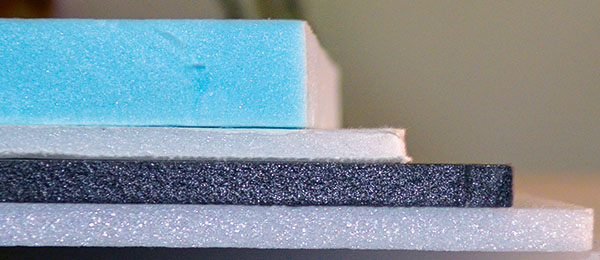
Written by Dave Lockhart Sports & Aerobatics As seen in the Spring 2014 issue of Park Pilot
Balsa or foam? Which flies better? This topic of conversation has passionate advocates on both sides. Within the realm of park fliers, the question is slightly broader because today’s pilots have a wide variety of construction materials from which to choose—balsa, Depron foam, EPP (expanded polypropylene) foam, and a variety of branded/proprietary foams such as Styrofoam, Elapor, Z-Foam, etc.
A related question for pilots with an interest in learning aerobatics, or pushing the aerobatics envelope, is which type of construction is best for crashes or hard arrivals? Expanded polystyrene (EPS) is a commonly used white bead foam. In the past, Styrofoam was a popular material for park flyer models because it was lightweight and easy to mold. Today, EPS has fallen out of favor because it is not as durable as newer foams. It tends to break in irregular chunks and adhesion between the particles is often compromised in crashes. Additionally, EPS does not sand well, and is not compatible with as wide a range of adhesives as other foam types.

The extensive amount of carbon-fiber bracing on this Citrino from Donatas Design yields a structure that is resistant to aerodynamic loads, but difficult to repair if damaged.
When most people hear foamie, the image that comes to mind is the modern day plate/flat sheet foamie aircraft with carbon-fiber reinforcements. Depron is a brand name for extruded polystyrene foam. Airplanes intended for indoor flying are typically constructed of 3mm Depron, while airplanes intended for outdoor flying are typically constructed of 6mm or 9mm Depron. It has a good strength-to-weight ratio, is reasonably durable and, if crashed, tends to cleanly crack and break.
Depron foamies can be made rigid with the addition of carbon-fiber reinforcements, putting them in the running for the best-flying models. Repairs are easy because Depron is compatible with CA, epoxy, and UHU por. The majority of competition-grade indoor foamies are made of Depron with carbon-fiber reinforcements.

The “skin” of the hot-wire-cut airfoiled wing and the EPP box-fuselage structure on the Fancy Foam Models 42-inch Extra 330s are key to maintaining rigidity on this large, but lightweight and durable outdoor aerobatic model.
EPP is another popular foam type. Compared to Depron, EPP is lighter weight and more flexible. Indoor EPP foamies typically use 6mm-thick sheets, while outdoor EPP foamies use 9mm-thick sheets or even thicker pieces that are cut from large blocks.
Airfoiled wings can be cut from EPP using a hot wire bow, which leaves a hard skin, improving the rigidity at the expense of some durability and added weight. EPP foamies are often described as “bounceable.” In crashes, the EPP flexes, bends, and is dent and ding resistant. Most minor crashes result in no damage, and in major crashes, the EPP tends to tear, but it does not compress or deform.
Companies such as Fancy Foam Models and Twisted Hobbys produce a large number of kits advertised as durable, aerobatic trainers capable of absorbing minor crashes without breaking.
EPP is compatible with CA and epoxy, but more flexible glues such as UHU por, Beacon Foam-Tac, or Welder provide a better bond, with a slight penalty for drying time. As with Depron foamies, EPP models can be reinforced with carbon fiber, but EPP-based models will never be as rigid as Depron-based models of the same weight.

This Arrow V.6 from Donatas Design is a 3mm Depron foam model reinforced with carbon fiber to yield a stiff and light airframe that retains durability.
Hybrid foams, such as Elapor and Z-Foam, have become popular because they are easy to mold and provide a good balance between strength and weight. Hybrid foam types have allowed the size and performance of the models to noticeably increase compared to traditional EPS foam.
Companies such as E-flite and Multiplex offer a wide range of models constructed of Elapor and Z-Foam. Hybrid foams typically accept a wide range of adhesives, so most models can be repaired from multiple minor crashes, and maybe even a major crash or two. Individual replacement parts are often available as an alternative to repairing a broken part.
Most experienced modelers are familiar with the adage “balsa flies better.” A properly designed and constructed balsa model takes advantage of the balsa grain (and possibly carbon-fiber reinforcements) to produce a structure with a high strength-to-weight ratio. Balsa-based airframes are generally the lightest and most rigid and ultimately yield the fastest control response and widest flight envelope.

This 6mm EPP Raptor from Fancy Foam Models is a durable aerobatic model that performs nearly as well as a Depron or balsa model. Mike Bailey photo.
Good balsa models typically survive hard landings and wingtip drags without incurring damage. Aircraft in severe crashes can usually be repaired, sometimes with the addition of splints, or by replacing sections of the structure.
The covering material also must be replaced. In many cases, replacing a wing panel, rudder, motor box, or control surface is the most effective option. Many of the most popular “woodies” are well supported with spare parts at reasonable prices—Extreme Flight R/C and 3D Hobby Shop come to mind.
All of the materials described have benefits and disadvantages, so picking the best type of material depends on a pilot’s priorities.
Another factor to consider is the amount of time and skills available for initially building/assembling the model, as well as repairing it if/when crashes occur. My own hangar has examples of each of the construction types described, and are all good fliers. I tend to fly the EPP models more aggressively.

This 60-inch Extreme Flight R/C Extra, constructed from balsa and carbon fiber, has an ultralight, but rigid airframe. The low weight allows it to be flown in smaller spaces, and the 48-inch version can be flown in an average baseball field.
Written by Dave Lockhart | [email protected]





